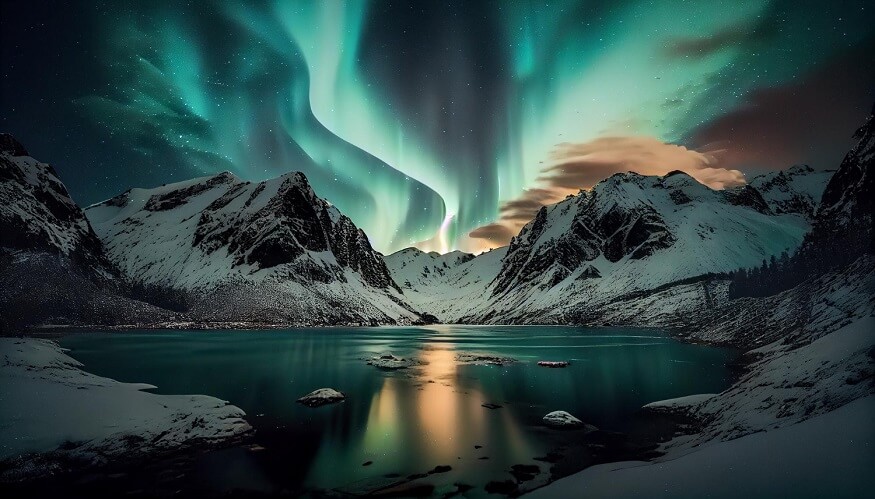The Northern Lights are also known as the Aurora Borealis. The magical lights are one of nature’s most mesmerising displays. But what exactly are these magical lights, and how do they come to be? If you are keen to witness this natural spectacle, read on to discover the science behind the Northern Lights, where to see them, and the optimal times and places for the best view.
How Do Northern Lights Work?
To understand the Northern Lights, we must first travel 149.6 million kilometres away from Earth – to the Sun. Our Sun is a gigantic, constantly active ball of gas. At times, it releases what we call solar winds, which are charged particles hurled into space. When these particles collide with the Earth’s magnetosphere, they interact with the gases in our atmosphere, predominantly oxygen and nitrogen. As these particles collide with the atmospheric gases, energy is released in the form of light. The colour of the light depends on the type of gas and the altitude at which the collision occurs. For instance, green is the most common colour and is produced by oxygen at lower altitudes, while red is produced by oxygen at higher altitudes. Nitrogen can produce purples, blues, and even pinks.
Also Read: What are the Northern Lights? Myths and legends of Aurora Borealis
What Causes the Northern Lights?
The intensity and frequency of the Northern Lights depend largely on solar activity. The Sun goes through an 11-year cycle of increasing and decreasing activity. Periods of high activity, known as solar maximums, are more likely to produce vivid and frequent displays of the aurora. Conversely, during a solar minimum, displays are less frequent and may be fainter.
Another factor that affects the Northern Lights is the tilt of the Earth’s magnetic field. The more aligned it is with the incoming solar wind, the more intense the auroras are likely to be.
The Science Behind the Colours
The different hues of the Northern Lights are the result of collisions between charged particles from the sun and gases in the Earth’s atmosphere. The specific colours we observe are determined by:
Type of Gas Molecule:
Oxygen: This abundant molecule in our atmosphere can emit green or red hues depending on the altitude.
Nitrogen: Responsible for the blues, purples, and even some reddish or pinkish colours in the aurora.
Altitude of Collision: The altitude where these collisions occur greatly determines the spectrum of colour produced.
Green (about 60 to 240 kilometres above Earth): At these intermediate altitudes, oxygen collisions are more likely to produce the common green hue.
Red (above 240 kilometres): Oxygen at higher altitudes tends to give off a deep red hue.
Blue and Purple (up to about 96 kilometres): At these lower altitudes, the reactions with nitrogen produce rich blue and purplish-red colours.
Pink: This colour can be seen when there’s a mix of oxygen and nitrogen reactions.
Energy of the Particle: The energy of the incoming particle can influence the colour as it defines how “excited” the atmospheric gas molecule becomes. The level of excitement of a gas molecule can cause it to emit photons at different wavelengths, corresponding to different colours.
Density of the Atmosphere: The density of the atmosphere can change the pressure and thus influence the wavelength of the emitted light. Lower pressure environments might cause a shift in colour that the human eye can detect.
The Brilliance and Patterns
Auroras don’t just shine in singular colours. Often, they present a wavy, shifting dance of colours, with green bands dappled with pink edges and hints of yellow, or purples fringed with blues. These patterns are shaped by the Earth’s magnetic field. As charged particles flow along the lines of the magnetic field, they create currents. These currents can further interact and create dynamic and complex patterns in the sky, such as spirals, arcs, curtains, or rays.
Also Read: 20 facts about North America that children would love
Where to watch the Northern Lights?
The Northern Lights are typically visible in high-latitude regions around the Arctic and Antarctic. While the Southern Hemisphere has its own version, the Aurora Australis, our focus here is the Aurora Borealis of the Northern Hemisphere.
Countries that lie in the Arctic Circle, such as Norway, Sweden, Finland, Canada, and Russia, offer some of the best views. However, the lights can occasionally be seen further south in places like Scotland or even Northern England, particularly during periods of high solar activity.
Also Read: 20 facts about Europe that children would love
Best Time to Watch the Northern Lights
Winter months, from late September to late March, are generally the best times to view the Northern Lights. This is due to the long, dark nights that provide an optimal backdrop for the light show. Remember, you will need clear skies to get the best view, so always check the weather forecast and aim for times when the skies are predicted to be clear of clouds.
Additionally, while the auroras can be active any time of the day, they are most often visible between 10pm and 2am local time.
Where to Watch The Northern lights
The following are the best places to witness the Northern Lights or Aurora Borealis:
Tromsø, Norway: Known as the “capital of the Northern Lights,” Tromsø is perfectly located in the middle of the Northern Lights Oval, which means a higher probability of sightings. The surrounding landscape of fjords and mountains enhances the experience.
Kiruna, Sweden: Located in the Swedish Lapland, Kiruna not only offers a fantastic view of the auroras but also boasts the world-famous ICEHOTEL, giving visitors a unique lodging experience.
Rovaniemi, Finland: Positioned just on the Arctic Circle, this Finnish city is a popular spot for aurora chasers. Apart from the lights, you can also visit Santa Claus Village and experience Sami culture.
Fairbanks, Alaska: One of the best places in the U.S. to see the lights, Fairbanks boasts frequent and intense displays. The city even has an aurora forecast to help visitors plan their trip.
Yellowknife, Canada: The capital of Canada’s Northwest Territories, Yellowknife is renowned for its clear nights and high aurora activity, making it an ideal spot for sightings.
Also Read: Top Ten Activities for Kids to Learn Geography
The Northern Lights are not just a fascinating visual phenomenon but also serve as a beautiful reminder of the wonders that the natural world holds. If witnessing the Aurora Borealis is on your bucket list, armed with the knowledge of where and when to go, you are well on your way to experiencing one of nature’s most enchanting spectacles.
EuroSchool provides students with a strong foundation in the understanding of natural phenomena. EuroSchool students learn about natural phenomena through a variety of methods, including classroom instruction, field trips, science fairs, and extracurricular activities.










